|
FAQs on
Pike
Cichlids
Related Articles: Pike
Cichlids, Oscars, Neotropical Cichlids, African Cichlids, Dwarf South American Cichlids, Cichlid Fishes in General,
Related FAQs: Neotropical Cichlids 1, Cichlids of the World, Cichlid Systems, Cichlid Identification, Cichlid Behavior, Cichlid Compatibility, Cichlid Selection, Cichlid Feeding, Cichlid Disease, Cichlid Reproduction,
|
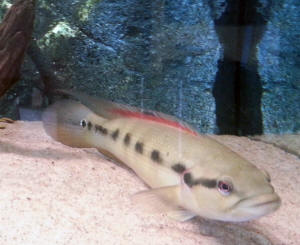
|
|
Pike cichlid ID/question
8/9/19
Greetings, WWM fishy folks …
<Hello Linda,>
I have a bonded pair of pike cichlids I got as juveniles (about the size of an
average index finger when purchased) from a local big box store — they were
unhelpfully labeled ‘pike cichlids’ and of course the staff had no idea what
species they were or proper care instructions for them.
<My first introduction to Pike Cichlids was much the same.>
I raised them among other SA cichlids at around neutral pH, and they are now
between 20-25 cm long (the one I believe is the male is larger) with the
approximate girth of a hefty banana. Internet resources have had a lot of
conflicting information, and I haven’t been able to determine whether I have C.
strigata or C. sp. “Venezuela.”
<I do not think these are the true Crenicichla strigata, which probably aren't
imported much, if at all. But do agree we're looking at the Crenicichla lugubris
group of species, which includes both C. strigata and C sp. 'Venezuela'. I
suspect that given the hazy understanding that scientists have of this species
group, and the hopelessly muddled (and misidentified) photos in the aquarium
press, pinning down the precise species would be difficult. Indeed, if these
were tank-bred species we might even be dealing with hybrids.>
The male in the photo has his ‘threat dress’ on, which he adopts whenever he’s
trying to warn me away from taking photos; the lateral stripe is usually absent
similar to the female.
<Yes, and the rosy belly on the female is indicative, too.>
Have you any idea from the photos what they might be?
<See above; Crenicichla lugubris group, but precise species hard to say. But if
I was pushed, I'd probably go with the C sp. 'Venezuela' sold as Crenicichla
strigata over the years, but probably not that species as such. Crenicichla
lugubris itself is another option, but the lack of red would seem to indicate
against that.>
The pair currently reside in a 180 gallon tank with a silver Arowana and a young
giant gourami who, as you might observe, is an avid photobomber. There used to
be an adult short-bodied marbled bichir in there as well, but the pikes began
harassing her as they seemed to want to claim the entire tank bottom as their
own — at least the parts with hides — so I moved the bichir.
<The smaller Bichirs are rather too gentle to keep with potentially aggressive
cichlids; indeed, have seen such Bichirs stripped of their fins when kept with
"peaceful for Mbuna" Yellow Lab cichlids.>
Recently, however, the pikes have shown what I believe is nesting behavior.
<Oh dear!>
They’ve been digging out hollows under logs and spending much of their time
there, and over the past few days the larger of the pair has been harassing the
gourami and even the 18” Arowana when they comes near their burrow. So far there
hasn’t been any damage inflicted (except when the Aro got startled and jumped
into the center brace, knocking off a few scales), but I worry that if they do
start spawning they might cause major havoc in the tank, particularly with the
Arowana being naturally prone to jumping.
<A correct analysis. Breeding Pikes is not something to be undertaken lightly.
They produce large broods of eggs, potentially thousands of them, and the market
for juvenile Pike Cichlids is tiny, at best. So it's arguably not even worth
doing. But yes, once defending their eggs, the Pikes will attempt to destroy
anything that gets too close. Your problem with moving the Pikes to a smaller
tank is if they're stressed enough to de-pair, there's a risk of them becoming
aggressive towards each other.>
Would a 75 gallon aquarium be large enough to isolate them long enough to finish
spawning provided they get frequent water changes?
<Yes.>
Thanks in advance for any assistance you can offer!
Cheers,
Linda A
<Good luck with these fabulous and evidently very healthy fish! Neale.>
|
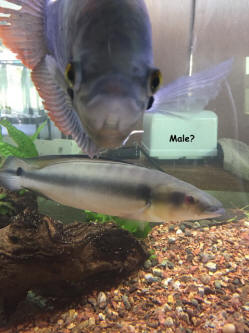
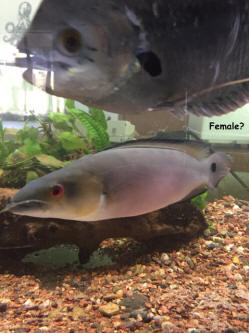 |
|
Red pike problem please help
11/20/15
Can you guys help me identify this and what i might do to solve this problem its
in a friends fish tank looks like hole in the head maybe and some sort of fungus
but im really not sure thanks
Jeremy
<Almost certainly Hole-in-the-Head, though of course secondary infections
(bacteria, fungi) can infect the open sores on the head and lateral line system.
Metronidazole is pretty much the only reliable treatment. You also need to
determine why this has happened. Poor diet and high nitrate are almost
always the causes. With carnivorous fish you the special problem of how to get
vitamins (mostly in plant foods) into them. If your Pikes take quality
pellets, then that's not a big deal, and simply offering the odd earthworm or
gut-loaded river shrimp will top them up nicely. The problem comes when folks
feed them just minnows or whatever. Such foods have little vitamin content,
contain thiaminase (which breaks down vitamin B1), and introduces all sorts of
unknown parasites and pathogens. Sadly, because the folks selling predatory fish
sometimes tell inexperienced fishkeepers to "just add a few Goldfish" for food,
this sort of horribly sick predatory fish situation is extremely common. Anyway,
treat as per HLLE, and optimise diet and water quality. Cheers, Neale.>
|
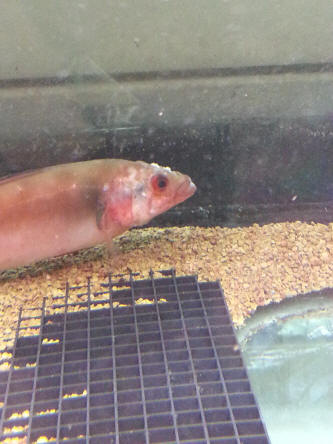
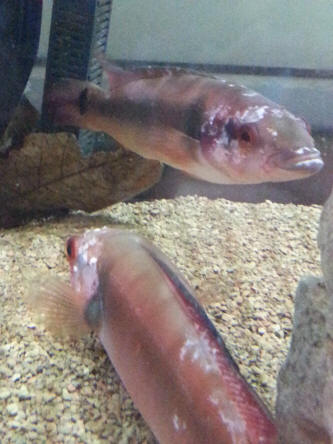 |
|
re: Red pike problem please help
11/20/15
Thanks for getting back so quick
Jeremy
<You're most welcome! Neale.>
|
|
Dwarf pike ID, is this a female belly crawler?
9/19/12
Hello crew!
<Aslak>
I've had this little guy (I thought it was a guy anyway, but from what I now
understand it's probably a girl)
<Appears to be so>
for about six months. He/she was rehomed from my 75g Amazon tank to my
living room 140 gallon planted community display tank. The tank has sand
substrate, Congo tetras, leopard bush fish, a black ghost, two green
Severums, a small tire track eel and assorted smaller type "Plecos". I know
it's a bit of a mix and match, but everyone seems to get along fine and
there's no out of place aggression.
<Thus far...>
Anyway, I can't remember what she was sold as, but I remember it being
wrong, and I have since tried to ID her. The red coloration happened
recently, and appears to be female breeding colors of the belly crawler?
<May be this Crenicichla species; can't quite be sure; the distinctness of
the lateral splotches, the reddish dorsal fin...>
Hopeful that you can confirm this, or might have an idea regarding the
correct species if it's not a belly crawler.
Thanks in advance!
Kind regards,
Aslak Evang
Norway
<Am sending this query to our resident Cichlid expert Chuck Rambo, for his
input. Bob Fenner>
|
 |
|
Dwarf pike ID, is this a female belly
crawler? 9/19/12
< Chuck's take. From the red coloration and the
spot in the middle of the dorsal fin it is definitely a female pike. It
probably is a Crenicichla cyanonotus that gets up to 20+ cm.>
|
Would a large pike co exists with a midas?
8/1/10
The pike is at the store and about 12 inches.
<No. Pike cichlids are South American cichlids and store-bought
"Midas" cichlids are hybrid Central American cichlids. They
have completely different water chemistry requirements. Plus, both
species can be extremely
territorial and the imbalance in size and jaw-structure here means that
fighting between them is likely to be asymmetrical. I have kept both
these fish, and wouldn't dream of mixing them. Of the two, Midas
cichlids are
most fun, and in a 200 gallon system my specimen got along fine with an
North American Gar, and Ictalurus catfish, a Gibbiceps Plec, some
Convicts, some Red-breasted Tilapia and a Jaguar Cichlid. The Midas
ruled the roost, and spent all his time at the front digging caves and
trying to scare away people who got too close to the tank. By contrast
my Crenicichla saxatilis pair had to be kept alone, and all they did
was hide, and frankly, they
were among the most boring fish I ever kept. Cheers, Neale.>
Cichlids, neotrop. cross repro. & Crenicichla sys.
-- 02/02/10
Hey WWM crew, I had a few cichlid questions. I just had 2 different
types of cichlids spawn. A male jack Dempsey and a female festae. Do
you know how they will look or anything of that sort?
<Something in between the two. Hybrids generally aren't
particularly attractive, and only in rare cases (and even then,
arguably) are the hybrid offspring worth rearing. In almost all cases,
hybrid eggs should be destroyed.>
Will they have any sale value?
<None. In fact a negative value. Hybrids are bad for the hobby.
Retailers sell them without telling people what they are, and even if
they do, some idiot will cross them with, let's say, a Jack
Dempsey, and sell what he or she calls "Jack Dempseys" onto
another pet store. So now you have fish that are 75% Jack Dempsey, and
25% Cichlasoma festae. Someone thinks they're getting a Jack
Dempsey, plans their aquarium accordingly, and ends up with an adult
fish that neither looks nor behaves precisely as it should. In short,
hybrids are bad. Producing hybrid fish is one of the most thoughtless
and harmful things hobbyists can do.>
Also, my LFS has 2 really pretty pike cichlids. One is called a franata
pike and the other is a golden pike.
<Crenicichla frenata and, I'm guessing, Crenicichla sp.
'Xingu I'.>
I have a 20 long aquarium with tons of plants. Some of the plants even
hang from the glass top for an overhang. Could these 2 go in there?
<Not a chance. Crenicichla frenata gets to at least 20 cm/8 inches
in length, and Crenicichla sp. 'Xingu I' to 30 cm/12 inches.
Both are extremely territorial and highly aggressive towards
similar-looking fish.
<<There are some "dwarf" Pike Cichlid species...
RMF>>
Pike cichlids generally are difficult to maintain, and as with any
carnivorous fish, an important task is weaning them off dangerous live
foods (like feeder fish) and onto proper foods (like earthworms and
pellets). Crenicichla spp are extremely sensitive to nitrate, and
keeping them in as large a tank as possible is crucial to long term
health. This is
much easier to do in tanks where they're kept alone, so there
isn't competition. On top of this, I kept a mated pair of
(wild-caught) Crenicichla saxatilis as a student, and while very
beautiful, these are very nervous, shy fish. They hid all the time,
except when feeding. Not that much fun, really.>
They're about 4 inches long each. The tank also has a 6 inch ornate
bichir in there. Thank you for your time.
<Always happy to help.>
P.S. A great plant for keeping cichlids and polypterids are those
reptile plants with suction cups. Be sure to rinse them off first!
<Yes, do agree with this strongly. The only thing to check is that
anything bought in a reptile store doesn't have exposed metal
screws or other components that might rust when kept underwater.
Ornaments and such designed for dry land use may not be safe in
aquaria. Anyway, thanks for the tip! Cheers, Neale.>
Re: Cichlids -- 02/02/10
Thank you very much.
<My pleasure.>
I'll just keep a few fry to myself and feed the rest to my
payara.
<Why bother? Just wash the eggs down the drain or let some catfish
eat them. Feeding live fish to predators tends to cause more problems
than it solves. While cichlid fry are safe in terms of thiaminase and
fat, using feeders does seem to encourage aggression in fish and
doesn't offer much scope for providing economical vitamin-rich
foods.>
About the pikes though, would a be able to keep one of them?
<With a big enough tank, sure. They are difficult to maintain, but
certainly not impossible.>
He would probably end up in a 40 breeder my himself.
<Too small. Do look at the "Dwarf" Pike Cichlids, but even
those are delicate fish, and keeping them properly isn't as easy as
their small size might suggest. If you want a predatory cichlid, and
plan to set a tank up for their needs, then I'd sooner recommend
things like Altolamprologus compressiceps or the rather lovely dwarf
Rhamphochromis. Both of these are fairly hardy, and most importantly of
all, can be weaned onto foods other
than live fish easily.>
If the pikes are a no go, what about Anableps?
<Not in a 40 gallon tank. Do read about the needs of these BRACKISH
water fish. They are schooling fish, and need a tank with a
"table" in the middle where they can rest (essentially a
slate propped up with a couple of bricks, with just enough water on the
slate for the Anableps to beach itself). Although quite easy to keep if
you can secure healthy specimens, very small specimens are notoriously
poor travelers.>
Or maybe a smaller cichlid like a Firemouth?
<Firemouth cichlids are a lovely, relatively mild sand-sifting
species ideally suited to aquarium life. Breeding pairs are
territorial, but because they are poor fighters (they have specialised
jaws) they shouldn't be combined with other cichlids. Best kept
with dither fish, such as Swordtails.>
Also, I'm assuming the payara cannot go in with the cichlids,
correct?
<We're talking Hydrolycus scomberoides, right? Indeed not.
Maximum length in the wild is something like 60 cm. Unfortunately they
almost always die after a few months or a year in captivity. So far as
I know, no-one has
kept these fish to maturity under home aquarium conditions. Massive
filtration and extremely frequent water changes are almost certainly
essential, given the riverine habitat of these predatory fish. In my
opinion, they shouldn't be in the trade at all. Cheers,
Neale.>
Sveni Pike Cichlid compatibility -- 09/26/09
I have the chance to get a sveni pike cichlid roughly 6".
<Ah, Crenicichla sveni, closely related to Crenicichla saxatilis.
Nice, if shy, fish.>
Would they be compatible with some lima shovelnose catfish.
<Provided the Lima Cats weren't too big to eat them, and
provided the tank had the strong, well oxygenated water flow
Crenicichla sveni requires, yes, they could be combined.>
The largest is 10", then I have three smaller ones about 5"
in a grow out tank.
<Hmm... very difficult to say if the 10-inch Lima is too big:
you're going to have to judge this yourself. My gut feeling is
they'll be fine together, but because Crenicichla are so slender,
they're comparatively at more risk
of being eaten than, say, a deep-bodied cichlid of similar length. This
said, Lima Cats are generally very mellow and once used to being fed
"easy to catch" foods like pellets and earthworms, aren't
especially predatory.
This is how public aquaria get sharks to live with smaller fish, by the
way; once predators get used to regular, easy meals, they don't
tend to view their tankmates as prey. If you're doing the *wrong*
thing and using feeder fish, then all bets are off, because you're
training your fish to attack any small fish dropped into the tank.
Moreover, the use of feeder fish appears to increase aggression, which
isn't going to help. I mention these issues because in some parts
of the world the dangerous and hopelessly outdated idea of using cheap,
store-bought feeder fish still persists, despite all the evidence that
Minnows and Goldfish in particular are unhealthy, and cheap fish are
disease-ridden.>
I am worried because both occupy the lower portion of the tank.
<Lima Cats are actually much happier at the mid to upper levels,
provided the vertical and/or horizontal overhangs are available. With a
bit of planning, you should be able to create some narrow crevices for
the Crenicichla, while also providing ledges or tall plants for the
Lima Cats.>
The larger tank would be a 90 gallon, footprint of 48" x 18",
the grow out is a 29 gallon, footprint 30" x 12". The other
thing I am worried about is either the larger catfish eating the pike,
or the pike eating the smaller catfish. Would it be safe to add the
pike to either of these tanks.
<As I say, depends on various factors. Cheers, Neale.>
Pike Cichlid ID/Info - 3/16/2006 My husband and I
recently purchased a Crenicichla xingu 2 and we are having a hard time
finding information on this particular species. I have found
2 pictures online, both of which are completely different from one
another. I wanted to see if you know any information on this
species and if you know what exactly they will look like when full
grown. Thank you. David Fillmore < Crenicichla sp. Xingu
II comes from the Rio Xingu river in Brazil. These are one of the big
ones and can get close to 18 inches when full grown. They prefer water
in the mid 70's F. A pH of around 7 is fine. It is a meat eater
that will take small fish as well as worms and frozen food too. It
likes a tank that is not too bright that is decorated with stones roots
and caves. The male is overall a faint steel blue color with the top of
his head being an olive color and the bottom of the head being an off
white. The female is the pretty one. She has an olive brown body with a
rosy pink belly. Her fins are red and edged in white and then black.
The top of the head is an olive brown but the bottom is a bright yellow
gold color. This is a pretty rare species in the hobby. Most of the
time the Crenicichla species Xingu I or better known as the orange pike
is offered for sale. The big problem with pike is that they need clean
water or they start to get sick.-Chuck>
Pike Cichlid Beat Up And
Hiding Hello, I have a 3 inch golden pike which has
a problem. He was originally in a 55 gallon tank
along with a 5 inch tiger Oscar, a 3 inch jack Dempsey, 2
inch Pleco, and a 2 inch catfish. The 55
gallon tank is temporary and eventually they will be in a 90
gallon tank. Yesterday I noticed that my pike
had some red spots on his side which I could tell were not
part of his colorization. I spoke to a guy at the
LFS who knows his stuff, and he told me it is probably
hemorrhaging, caused by the other fish who are picking on
him. Then today I noticed that he would not
come out of his cave and when he did he got viciously
attacked by the Oscar and Dempsey. I took him out
of the tank and placed him a 10 gallon tank which I had
bought recently as a quarantine tank. However the tank
has gotten a chance to cycle and has only been running for
half a day. I placed the pike in there because I though
he wouldn't make in the 55 tank another
day. He has been in the 10 gallon for about four
hours and hasn't moved at all, he's still breathing
but I don't know what to do. Any advice that you
could lend me on this situation would be greatly
appreciated. Thank you. Jim <Pikes really don't do
too well with other aggressive cichlids. The pike cichlids mouth is for
catching smaller fish. It doesn't do too well against other
cichlids that may bite it and break it. Your pike is pretty tough and
will probably recover from the attacks, but the tougher question is
where to put it. The other fish get big but your pike will not be able
to tolerate the more aggressive cichlids. Your pike will get about 18
inches when full grown s will need at least a 55 gallon tank all on his
own.-Chuck>
Pike Beat Up II Thanks for your quick
response. However since I sent my email to you
the Pike while in the 10 gallon still hasn't moved, eaten and
is breathing heavy and looks really
stressed. He still has the red marking on his
side. I even put so live food in the tank with him and he
didn't even acknowledge it. When I took him out of
the other tank (55 gl) I was treating it with
quick cure for protozoan parasites which some of the fish
had especially the Oscar. Can the parasite from
the 55 gallon be the reason for his heavy breathing and
stressed out condition. I put PimaFix in the 10 gallon
to help him, but nothing. Is there any medication
that I should give him that would help him
recover. Thank you in advance for your help. Jim
< Sounds like you pike really got beat up. The Nitrofuranace will
help with both bacterial and fungal infections. If you pike is listless
and non-responsive you could try adding a teaspoon of rock salt per 5
gallons, but after that there is not much you can do except keep the
water clean and warm (80+F).-Chuck>
|
|

